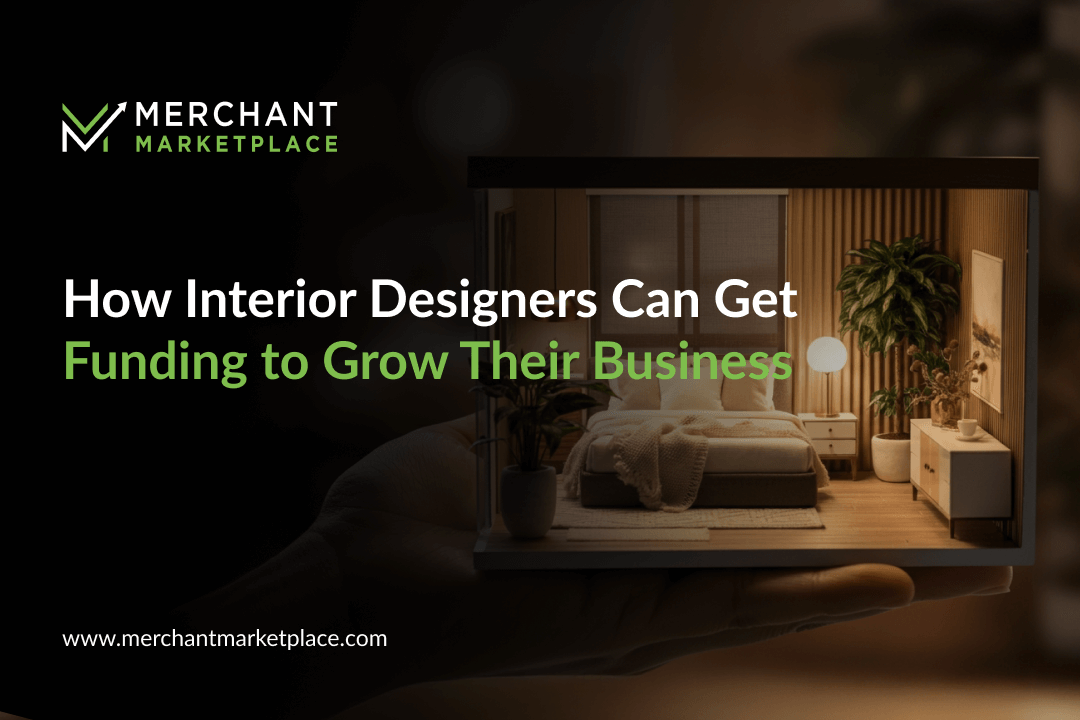The interior design game is hotter than ever; clients are spending big bucks on home makeovers, remote work setups, and those envy-worthy showroom builds. But here’s the kicker: even with all that action, designers still run into some serious friction.
Cash flow gets jammed up with slow client payments, seasonal slowdowns hit hard, and the upfront costs? Brutal. Truth is, creativity alone won’t cut it; you need financial firepower to really level up. That’s where funding steps in. We’ll walk you through how to prepare your design business so when the moment hits, you’ve got the right kind of money flowing fast.
Why Interior Designers Need Business Funding
Interior designers often bootstrap early on, blending personal savings with small gigs. But to scale wisely and sustainably, professional funding becomes vital. You might want to build a studio, onboard team members, expand offerings, or invest in equipment. Without capital, growth stalls, and opportunities slip away.
Common Expenses in a Design Practice
Office or studio space: Renting or leasing a functional studio/meeting space can be expensive upfront.
Project materials and inventory: From samples to custom furniture, you often incur costs before the client pays.
Hiring assistants or contractors: You might need Freelancers or in‑house hands help to manage higher volumes.
Technology and design software: Licenses are needed for CAD tools, render engines, project management platforms, and subscription services too.
Marketing and branding: People should see your work, let it be photo shoots, social media ads, portfolio updates, or simple website hosting and SEO.
These are recurring or pretty large one‑off costs that require cash up front before the revenue starts pouring in.
Growth Opportunities that Require Funding
Expansion into new cities or other markets: Opening the second studio requires you to look for financing for new leases, new recruits in local regions, and travelling costs for gaining the necessary insights to cater to that market.
Offering virtual design services: Now to go fully remote, you’ll need decent funds to invest in 3D software, good client communication tools, as that digital workflow makes virtual collaboration smooth and professional.
Launching a product line: You need money to source materials, make a prototype, and package. Launching a line takes upfront cash, plus funds for e-commerce setup, warehousing, and marketing if you’re building from scratch.
That kind of expansion demands capital, not just creativity.
Top Business Funding Options for Interior Designers
Business Credit Cards
To cover everyday expenses or short-term costs, being an interior designer, Business credit cards get you quick funds and flexibility. They’re easy to apply for and great for managing smaller purchases like software subscriptions or marketing ads.
On the plus side, approvals are fast, you can earn cashback or points, and they help smooth over cash gaps. The downside? Your credit score would be hurt badly if you mismanage and incur high interest if you don’t pay off the balance monthly. They’re best if you pay them down quickly, as they’re good for short-term spending.
Small Business Loans
You can get small business loans with larger amounts and longer terms. This in itself provides a world of possibilities for a designer to make serious moves such as expanding a studio, purchasing equipment, and setting up a team. Anything like SBA 7(a), microloans, or conventional bank loans will have better rates and repayment plans. Pros include access to major capital and lower long-term costs.
The catch is the process; it’s slow, paperwork-heavy, and often needs strong credit or collateral. This option fits best if you’re planning big, strategic growth and have the time to wait.
Business Lines of Credit
A business line of credit gives you the flexibility to tap into the funds as you need. Just like a credit card, but comes with more generous limits and is better suited for business cycles. Pay interest on what you actually use, especially when there’s seasonal slowdowns or you have multiple projects to juggle.
The flip side? Interest rates can shift, you might face annual fees, and your credit line could be reduced after reviews. This is ideal for managing uneven cash flow or covering shortfalls without locking into a loan.
Merchant Cash Advances
Merchant cash advances offer lightning-fast funding by pulling a percentage of your future credit card sales. It’s super convenient, especially if you’ve got regular card transactions. The big advantage is speed; funds can hit your account within a day or two, and no collateral is needed.
This path works best if you’ve got strong daily revenue and need a short-term cash boost with no time to wait.
Equipment or Furniture Financing
You can spread out the cost with this, instead of paying all at once for equipment or furniture. This protects your working capital while still letting you grow. Let it be for setting up a showroom or to upgrade your studio.
The pros include manageable monthly payments and the chance to invest in high-quality assets. But interest adds up, and you’re often tied to the asset, miss a payment, and it might get taken back. It’s a smart move when launching or upgrading a space with big-ticket items.
Invoice Factoring / Receivables Financing
Get immediate cash for every unpaid invoice. Access the funds ready to be released to you from your client’s bills. So you can continue to move projects ahead, rather than having to hold on for 30, 60, or 90 days for payment to come through.
The good? Fast cash with no new debt. The bad? You lose a slice of your earnings to the factoring company, and client relationships might get impacted. It’s best for designers with steady invoicing who need cash flow without piling on loans.
Grants for Creative Professionals
Grants are the golden ticket that you don’t have to pay back, letting you get funds from arts councils, nonprofits, or foundations that support innovation in design. You’re a strong fit if your work aligns with themes like sustainability, public impact, or research. The benefits are clear: no repayment, added credibility, and sometimes you even get mentorship and industry exposure.
But yes, they’re competitive, take a lot of time, and are often tied to specific projects. As a designer, if your projects are meaningful and align with the grant’s mission, you can easily land one.
How to Prepare Your Interior Design Business for Funding
Build a Business Plan
Lay out your mission, services, client base, market trends, financial projections, and growth roadmap. How much cash do you need? Where’s it going? Clear strategy wins lenders’ trust. Investors look for product‑market fit (even for services) and scalability.
Improve Your Credit Score
Both personal and business credit matters. Small Business Administration (SBA) loans, like the 7(a) or 504 programs loans, require good personal credit and often collateral. Pay bills on time, limit credit utilization, and clean up any negative records.
Organize Financial Documents
Have income statements, balance sheets, tax returns, bank statements, client contracts, and past project costs ready. Lenders and investors need to see consistent, clean records.
Define Clear Funding Goals
Get crystal clear on the amount you need and why you need it. Instead of vague guesses, break it down – like needing $50K to open a new studio, bring on staff, and upgrade your tech. When you spell out exactly how the funds will fuel growth, lenders take you more seriously and you’re more likely to land the right type of financing.
Tips for Choosing the Right Funding Option
Compare interest rates, fees, repayment terms: Compare total cost, not just speed. SBA loans have low rates but slow approvals. MCAs are fast, but fees add up quickly.
Consider how quickly you need funds: If you need cash fast, credit cards or MCAs work. For bigger plans, expect longer timelines with bank or SBA loans.
Align funding with growth stage: Match funding to your stage. New designers might use credit cards, growing firms go for loans or credit lines, and established studios may layer in equipment financing or grants.
Choose based on where you are and where you’re going, don’t force a fit.
Success Stories: How Designers Used Funding to Grow
- From Studio Dreams to Corporate Deals
A California designer used an SBA 7(a) loan (~$250K) to lease a storefront studio, match samples, hire an assistant, and invest in high-end rendering software. That enabled them to book bigger corporate clients and raise rates within a year.
- Turning Invoices Into Opportunity
A solopreneur interior stylist scaled up using invoice factoring. Since clients took 60 to 90 days to pay, he got cash upfront by selling his invoices to a factoring company. That helped him take on larger projects by boosting cash flow by clearing his debt faster.
Grant-Fueled Growth with Purpose
A mid‑career designer won a Creative Capital creative‑practice grant (~$50K plus advisory support) for a sustainability‑focused design series. The grant funded the development of a mini product line and exhibitions, boosting visibility, client interest, and revenue.
Conclusion
Expanding a design firm requires thinking big, especially regarding financial matters. Growth takes capital, whether you are doing, hiring employees, purchasing materials, spending on marketing, or rolling out new services. You can leverage strategic capital funding and access everything from credit cards to loans, credit lines, equipment financing, invoice factoring, or grants if you’ve planned carefully, started with good credit, and know what you want. Your job is to select the funding option that’s right for where you are and keep in mind how much funding you leverage.
Ready to scale your interior design business? Learn more about fast and flexible financing options tailored for creative professionals from our Funding Specialist.




